
Design surrounds us, from the digital interfaces we interact with daily to the advertising campaigns that shape how we perceive brands. But still, what gives these elements coherence and emotional depth is not just design itself, but art direction. In design, art direction means guiding the visual expression of an idea so that it connects with audiences on both a rational and emotional level.
The distinction matters quite a lot because design without direction can feel scattered. Art direction is crucial in turning visuals into stories — creating alignment between strategy, execution, and audience perception. When we look at a magazine spread, a product website, or a film scene, we engage with the vision of an art director who orchestrated the look and feel to communicate more than just your average surface beauty.
And this directly translates to business, where design-driven companies consistently outperform their peers in revenue and shareholder returns. This is not simply because they look good, but because design under thoughtful art direction becomes a business strategy that inspires trust and loyalty.
What Is Art Direction?
Art direction in design refers to the practice of shaping the overall visual direction of a project. It involves defining visuals' aesthetic, tone, and emotional resonance to convey the intended message consistently.
The art director acts as a central figure, working closely with designers, photographers, illustrators, and marketers to align their contributions. Where your day-to-day designers often focus on creating specific layouts or assets, the art director ensures that everything fits together. Direction means more than setting guidelines — making sure every visual decision reflects the story a brand wants to tell.
Art direction comes with both creative and managerial responsibilities. On one hand, it’s about choosing colors, typography, and imagery. Conversely, it’s about interpreting strategy, understanding audiences, and guiding a team toward a unified vision. The role of art is not to decorate, no; it’s to communicate. Art directors give design clarity and emotional power by turning abstract goals into tangible visuals.
Art Direction vs. Graphic Design
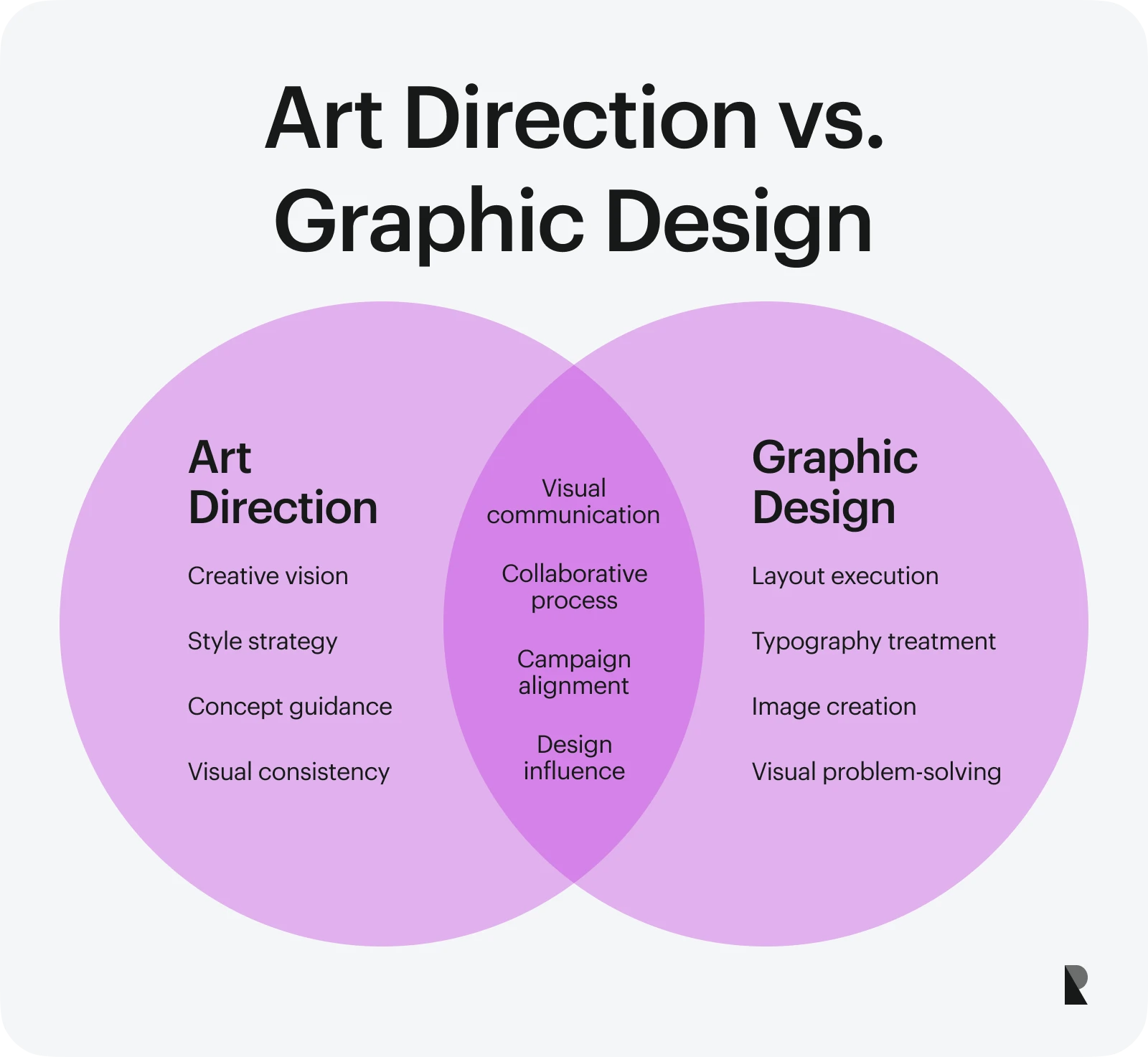
The difference between art direction and graphic design often confuses people, but understanding it is essential. Graphic design is all about execution. A graphic designer creates layouts, typography treatments, and imagery to solve visual problems. Art direction plays a broader role: it sets the strategy and defines the look and feel that guides the designer’s work.
Think about an advertising campaign. Here, the art director defines the overall style — perhaps choosing a muted color palette, emphasizing bold typography, and deciding on a photography approach that captures raw human emotion. The designer then applies these choices to create specific layouts like posters, digital banners, and social media assets.
This relationship is not necessarily hierarchical in nature, but rather collaborative. The art director seeks consistency and meaning, while the designer ensures precision and craft. Without art direction, even the best graphic design risks becoming fragmented. And without skilled designers, the best art direction remains only an idea.
Why Art Direction Matters in Design
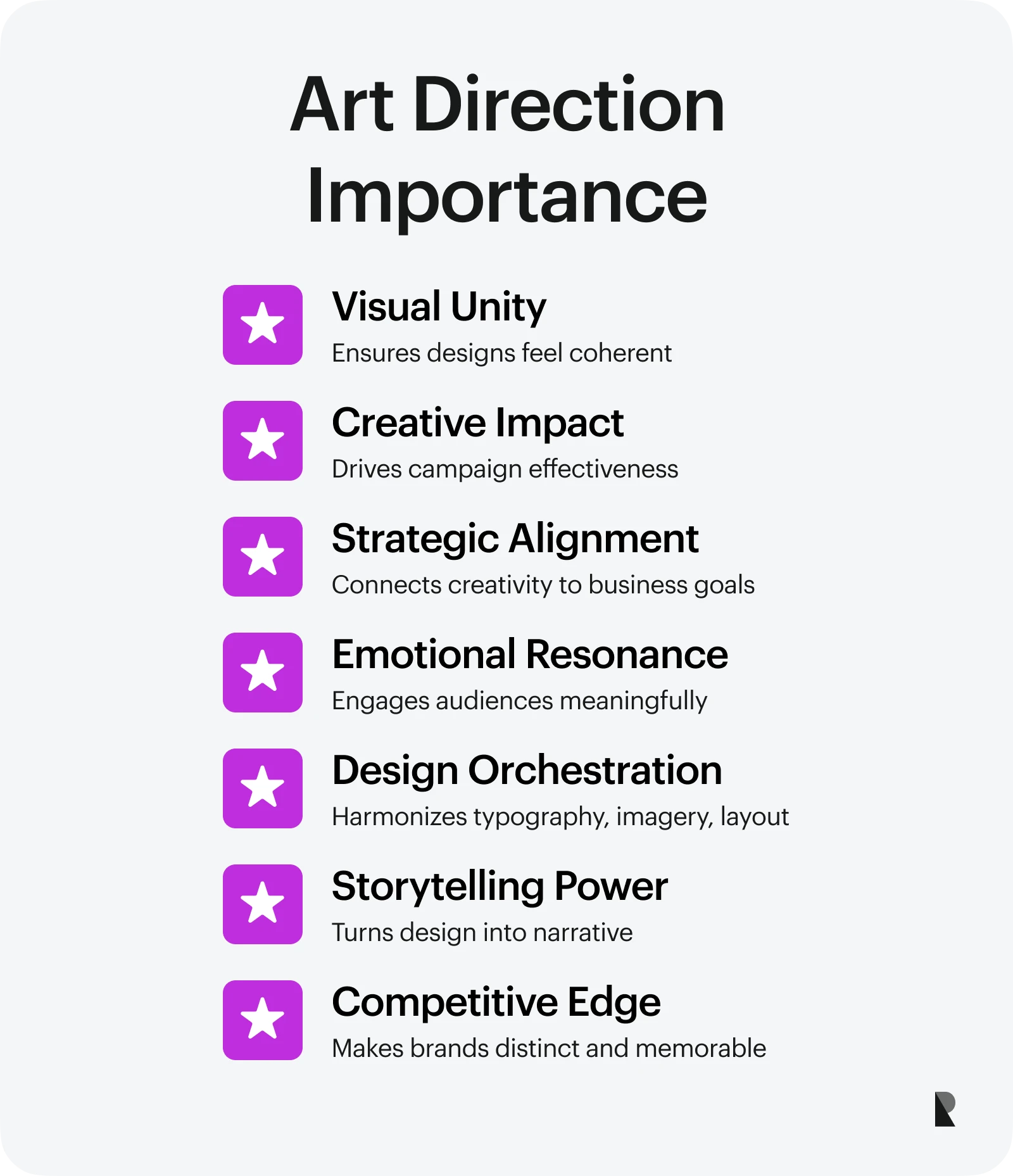
When we encounter visuals that feel like they belong together, we’re experiencing the impact of art direction. Without it, design often lacks integrity, resulting in a collection of disconnected parts. Art direction brings clarity, unity, and strategic value to the whole.
Research shows that creative quality is the dominant driver of effectiveness in communication campaigns. This shows why direction plays a crucial role: it ensures that creativity is purposeful, aligned with business goals, and emotionally resonant for audiences.
Art direction means orchestrating all design elements to reinforce a central idea. It helps ensure that typography supports messaging, imagery sparks emotion, and layouts improve readability. When every element works together, the art director turns design from execution to straight-up storytelling.
However, when every company fights for attention, art direction can also give brands an edge. The strategic layer makes communication look good, feel authentic, and be memorable.
Art Direction Across Design Fields
Art direction is not limited to one medium. It adapts to the needs of different industries, shaping how we experience advertising, digital interfaces, films, and editorial layouts. Each context highlights the flexibility and importance of this role.
Advertising
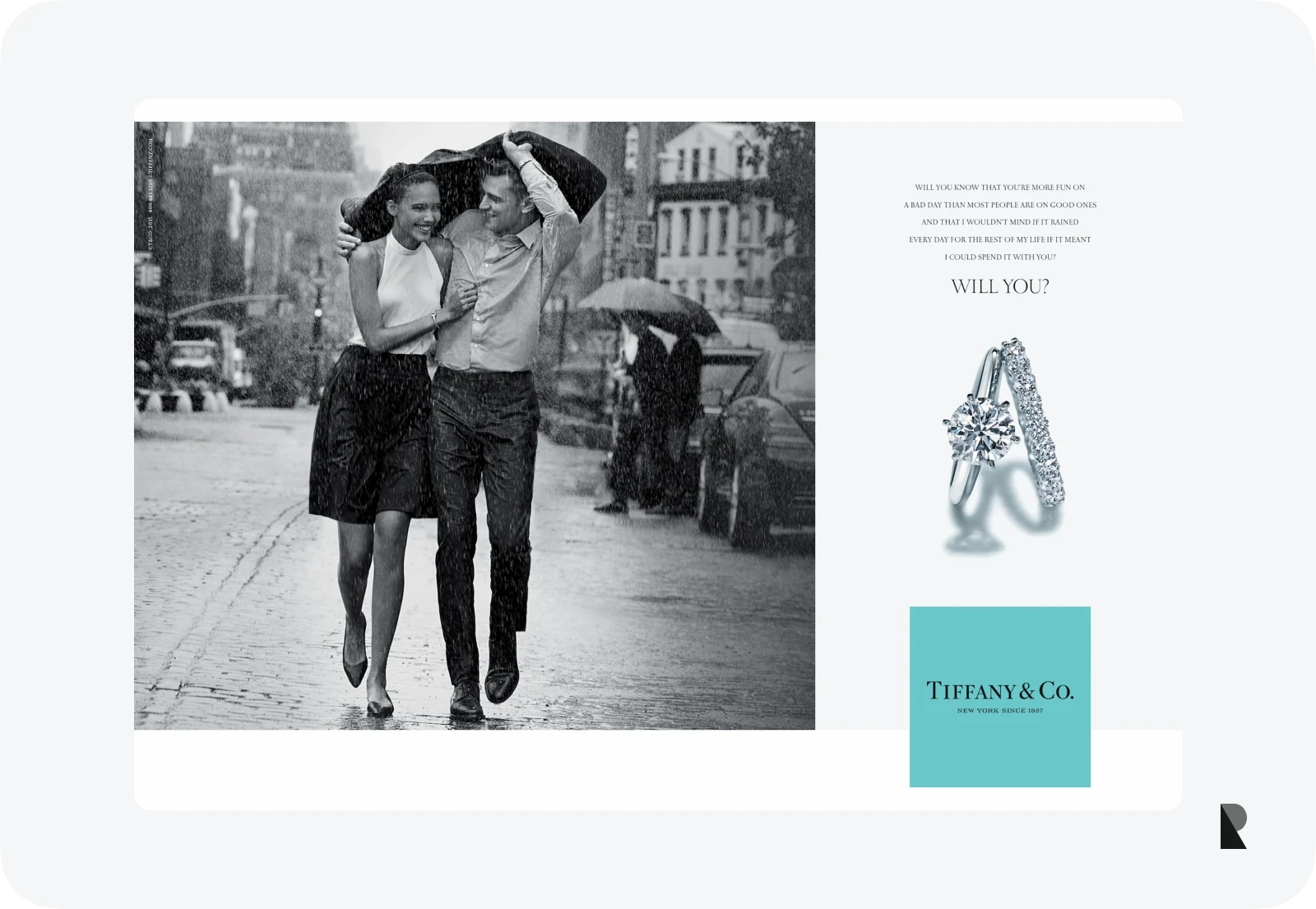
In advertising, art direction shapes campaigns that work across multiple channels. An art director defines the visual language — from the tone of photography to the treatment of typography — ensuring that every element pushes the central message.
Think of iconic campaigns where a single image or slogan immediately calls a brand to mind. These are designed intentionally and guided by art direction that connects brand strategy with consumer emotion. Without such leadership, campaigns risk inconsistency or diluted impact.
Web and digital design
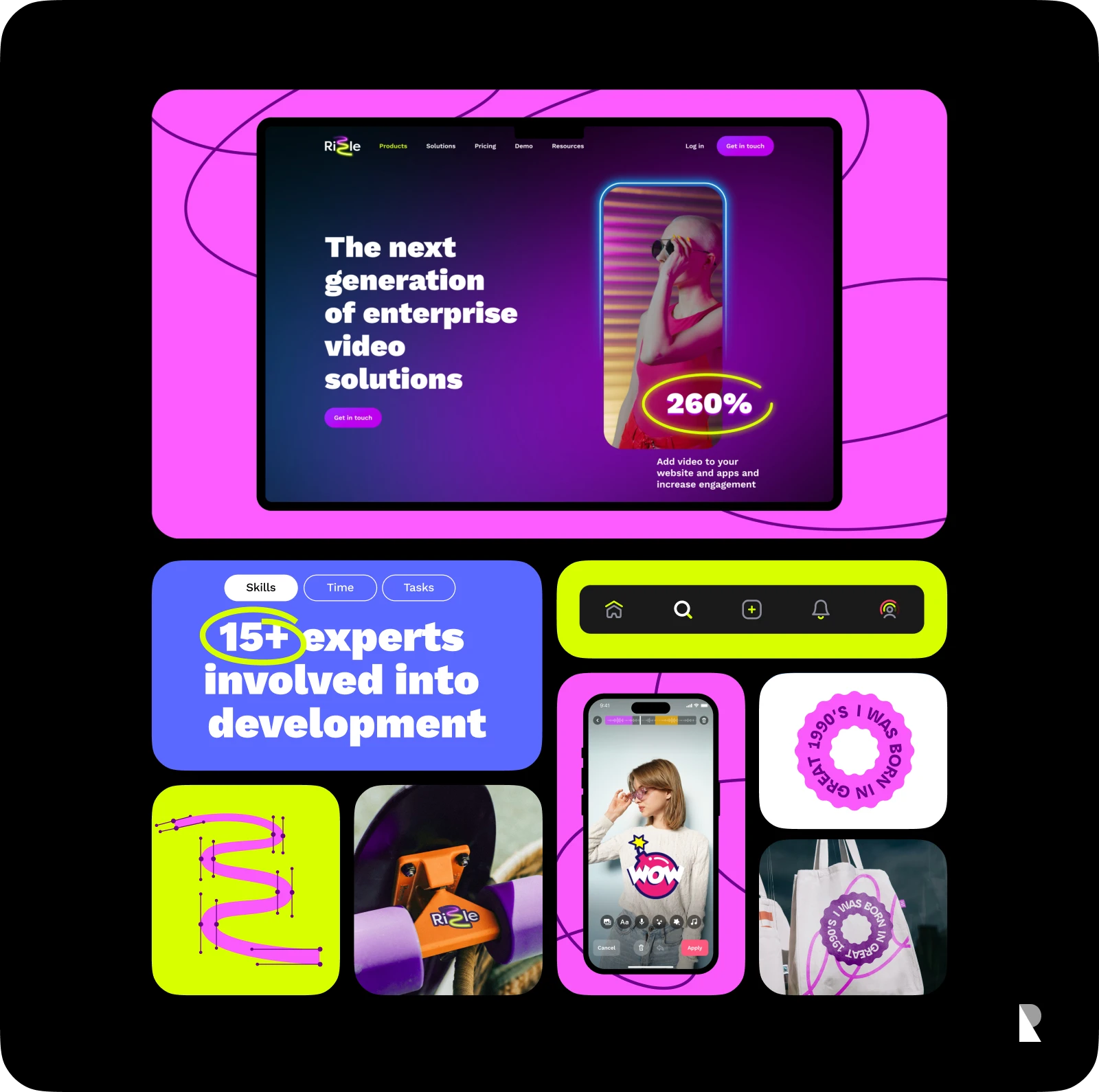
Art direction in digital spaces focuses on creating a memorable interface style and maintaining visual consistency. It involves making decisions about imagery, typography, and color palettes that guide users' interactions with products and services.
A well-designed app or website reflects both technical execution and vision. The art director sets the look and feel so that every page, button, and interaction strengthens the same brand story. Designers execute these elements, but the direction helps ensure cohesion across the digital experience.
Film and photography
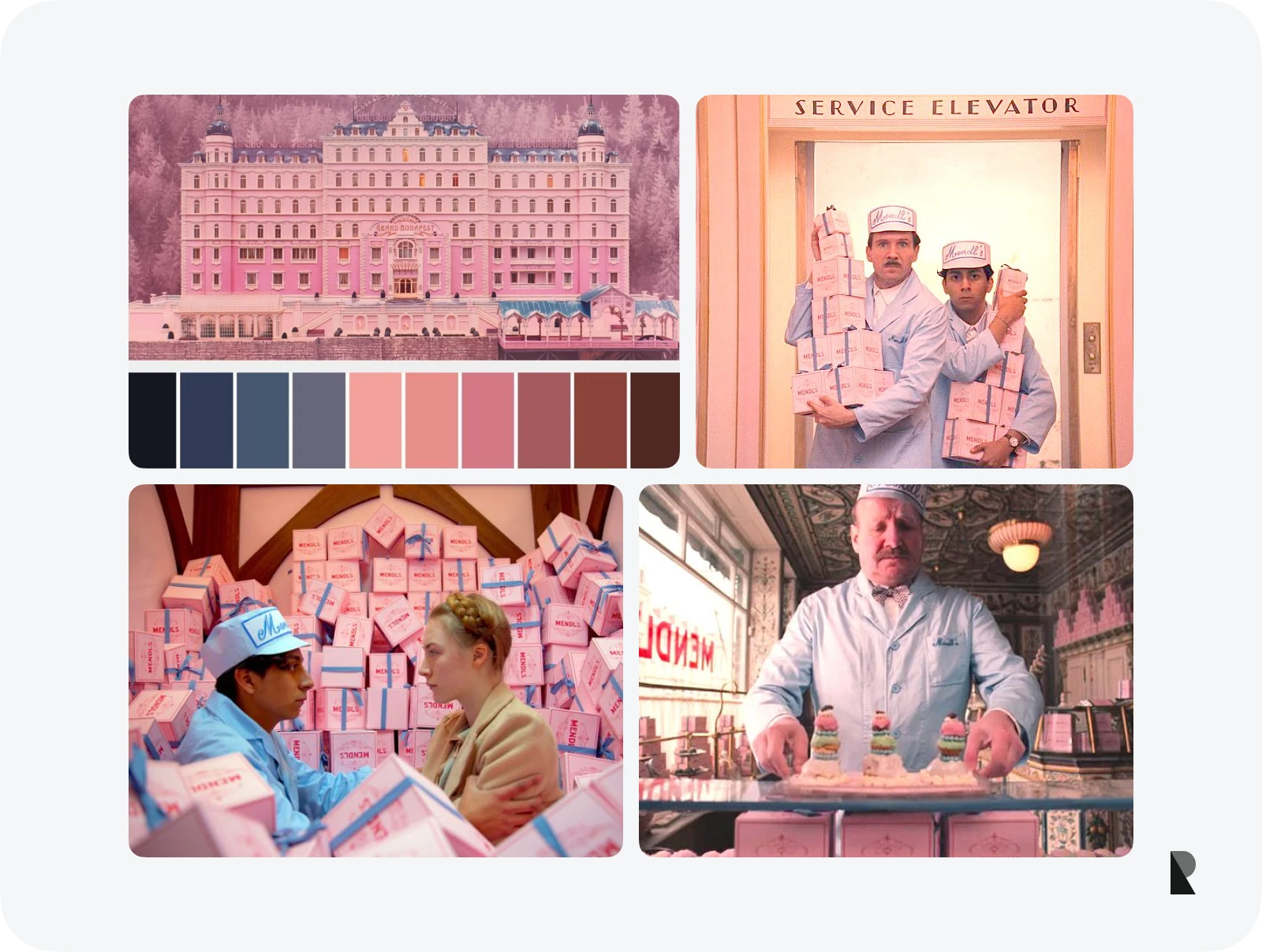
Film and photography are the clearest examples of how art direction shapes visual storytelling. In fields like these, direction means creating atmospheres, emotions, and narratives through visuals alone. The art director oversees everything from set design and color grading to costume coordination so that every frame communicates the right mood.
When we think of films that stay with us, we often remember the visuals: the muted grays of dystopian worlds, the saturated hues of nostalgic settings, or the significant contrasts of noir cinema. These are not accidents of design but deliberate choices, designed to show emotion and guide perception. And in photography, art direction guides how light, composition, and props contribute to an overarching theme, turning a collection of images into a unified story.
In both media, the art director is working to find continuity. Each visual has to align with the overall vision, creating immersion for the audience. This coherence — from the smallest detail in a costume to the broad aesthetic of a campaign — turns isolated shots into narratives.
Editorial and print
In editorial design, art direction shapes a publication's identity. Magazines, books, and catalogs all rely on a strong visual language to establish recognition and trust in the reader. The art director decides how photography interacts with typography, how white space guides the reader’s eye, and how color palettes reinforce tone and readability.
Let’s consider a fashion magazine. The designer might focus on individual spreads or layouts, but the art director is in charge of ensuring that the visuals maintain a consistent voice across dozens of pages. This can mean defining how photography styles shift with seasons or how special issues differentiate while still fitting the brand’s identity.
Iconic editorial projects demonstrate how powerful art direction can be. They show that when visuals are designed with strategy, they become more than images on paper. They become cultural statements that define eras and influence wider aesthetics.
The Broader Role of Art Direction
Art direction goes far beyond just managing visuals. It’s about making design decisions that reinforce strategy. It plays a role in brand development, where consistency and authenticity are critical. The art director often collaborates with strategists, marketers, and product teams, interpreting abstract goals into tangible visual outcomes.
This role also demands leadership. Designers and creatives need clarity, and the art director provides it by setting a direction that everyone can follow. This is not about micromanaging execution but about ensuring each contribution connects to the vision—the bigger whole. When designers work with this clarity, the outcome feels more purposeful.
Direction comes down to meaning. It is not just about arranging elements so that they look good. It is about ensuring they work together to express something essential. The audience should see the visuals and feel like they have entered a brand’s world.
Art Direction and Brand Strategy
In branding, art direction is where strategy meets design. A brand is more than a logo or color palette — a promise, an experience, and a perception shaped across countless touchpoints. Art direction is making sure that this perception is consistent and emotionally engaging.
When a brand launches a new campaign, the art director’s job is to ensure that the look and feel align with the brand’s values and voice. If the brand is forward-thinking and innovative, the art direction might lean toward minimalism, modern typography, and bold imagery. If the brand wants to feel approachable and warm, the art direction could emphasize softer colors, candid photography, and human-centered visuals.
Every choice is deliberate, anchored in strategy. The role of art direction is to make sure design choices are not arbitrary but connected to the bigger picture. This is where business goals and creative expression meet.
The Human Side of Art Direction
At its core, art direction is about people. It’s about how audiences perceive visuals, how teams work together, and how emotion is translated into design. A skilled art director knows that creativity is collaborative. They create an environment where designers, illustrators, photographers, and writers feel part of the same vision.
This is also where leadership is most visible. An art director balances feedback with guidance, ensuring the team feels supported while steering the project toward clarity. It requires empathy, because working with creative professionals means understanding their perspectives and helping them connect their work to a larger narrative.
Art direction also respects audiences. It allows visuals to communicate honestly, without manipulation or unnecessary complexity. The goal is not to overwhelm with decoration but to create meaning through design.
Why Businesses Invest in Art Direction
For most organizations, art direction is not just a creative luxury — it’s a business asset. Companies integrating design into their strategy outperform competitors (by a lot) in growth and returns, reinforcing that art direction plays a tangible role in business performance.
A campaign or product designed without strong art direction risks inconsistency. The result can be confusion, weaker brand recall, or wasted investment in visuals that do not connect with audiences. On the other hand, design shaped by clear direction amplifies recognition, builds trust, and supports long-term brand equity.
Creative quality really is the key to modern advertising effectiveness. In other words, how well a campaign is designed — and how consistently it communicates — has more impact than media placement or frequency alone. Art direction helps strengthen this quality by linking creativity to strategy.
Sep 19, 2025
